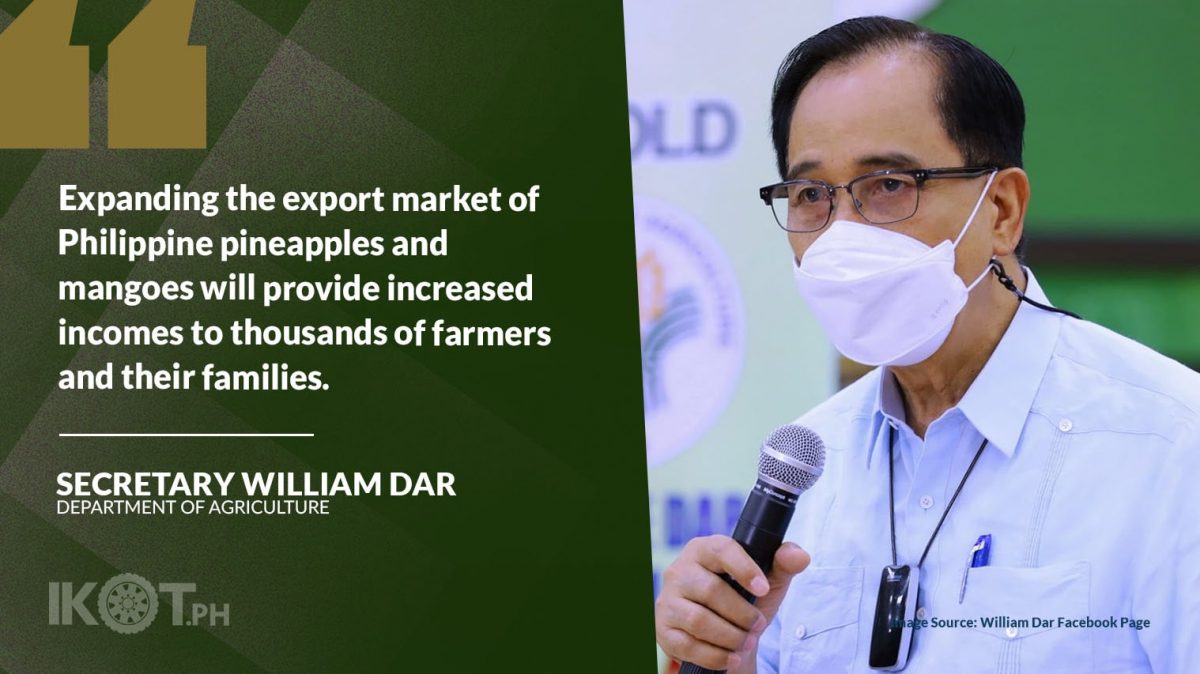Philippine-grown pineapples and mangoes will soon find their way through additional ports of entry in the United States.
This favorable development came after the Philippine Department of Agriculture’s Bureau of Plant Industry (DA-BPI) and the US Department of Agriculture’s Animal and Plant Health Inspection Service (USDA-APHIS) mutually agreed on and threshed out several pending issues, during a virtual meeting recently.
“Expanding the export market of Philippine pineapples and mangoes in the US and other countries will not only enhance our national economy but more importantly, provide increased incomes to thousands of farmers and their families in pineapple- and mango-producing provinces nationwide,” said Agriculture Secretary William Dar.
“It is a realization of one of the key strategies under our ‘OneDA Reform Agenda’ to transform Philippine agriculture.”
“Further, it is a realization of one of the key strategies under our ‘OneDA Reform Agenda’ to transform Philippine agriculture, that is, ‘Global Trade, Export Development and Promotion,’ with a focus on high-value crops,” Dar noted.
“On behalf of President Rodrigo Duterte and Filipino farmers, we, therefore, thank the officials of the USDA-APHIS and our DA-BPI for mutually resolving issues that would further increase trade between our two countries,” the agriculture chief stressed.
With the recent agreement between the APHIS and BPI, the Philippines could dramatically increase exports of pineapples and resume shipments of mangoes to the US via additional ports of entry, the agriculture head added.
Currently, Philippine fresh pineapples reach the US through Guam, Commonwealth of Marianas Island, and North Atlantic regions, according to the DA-BPI. From 2013 to July 15, 2021, exports amounted to only 346,190 kilograms (kg).
The country previously exported fresh mangoes to the US, from 2005 to 2008, totaling 386,099 kg, all produced in Guimaras Island, the DA-BPI added.
During the August 12 virtual meeting, the Philippine panel was led by BPI assistant director for regulatory services, Ariel Bayot, together with DA agriculture counselor to the USA and Americas, Dr. Maria Araceli Escandor, and Dayanara Lausa, desk officer for the Americas at the DA international affairs division.
The US delegation was led by Deputy Director Matthew Messenge, of the USDA-APHIS PPQ-Phytosanitary Issued Management Unit.
“The USDA-APHIS has accepted the evidence that the ‘Smooth Cayenne’ — the Philippines’ main export pineapple variety — is not a host to the oriental fruit fly.”
In a report to Dar, through BPI Director George Culaste, Joselito Antioquia, OIC-chief of the BPI National Plant Quarantine Services Division, said the USDA-APHIS has accepted the evidence that the “Smooth Cayenne” — the Philippines’ main export pineapple variety — is not a host to the oriental fruit fly.
The fruit pest, known scientifically as Bactrocera dorsalis (Hendel), is very destructive and often finds its way into the US, sometimes triggering wide-scale eradication programs.
APHIS is the main US agency responsible for protecting animal health, animal welfare, and plant health. It is also the lead agency for collaboration with other agencies to protect US agriculture from invasive pests and diseases.
Antioquia said APHIS will provide BPI with the risk mitigation measures for oriental fruit fly.
After the BPI agrees on the measures, APHIS will publish the initial notice in the Federal Register for a 60-day stakeholder comment period, review any comments, and then publish the final notice that allows the expanded market access for Philippine pineapples into the US, except Hawaii.
“The Philippines may start shipping pineapples to various US markets before yearend,” he added.
The USDA-APHIS also agreed to draft an operational work plan (OWP) for irradiation of Philippine fresh mangoes upon arrival in the US. The BPI will provide APHIS official comments on the OWP.
Irradiation is a phytosanitary treatment that uses ionizing radiation to prevent the introduction or spread of regulated pests by achieving either mortality, preventing successful development like non-emergence of adults, sterility or inactivation. Irradiation of mangoes upon arrival in the US is an option offered by the USDA in response to the request of the Philippines to remove pre-clearance inspection.
Another development that is seen to make agricultural exports to the US much easier is the country’s inclusion in the “ePhyto Hub,” which is organized by the International Plant Protection Convention (IPPC).
The “ePhyto” certification, which is also being pushed by the US, will replace official documents issued by governments with electronic forms to confirm that shipments of plants and plant products traded internationally are free of pests and diseases, and are therefore safe to import.
Traditionally, certificates are done on paper, which are transmitted between parties by post, courier, or other physical means. The process takes days to complete, and is prone to errors, loss, theft, and counterfeiting. Thus, it slows down trade and, at worst, results in spoiled goods, additional demurrage charges, and frustrated customers and governments.
The DA-BPI is in the process of developing the system to connect to the IPPC “ePhyto Hub,” said Antioquia.
The BPI and APHIS panels also discussed the latter’s request for market access of US fresh pomegranate exports to the Philippines.
He said the BPI has already narrowed the pest list scope for pomegranate to top state producers like California, Arizona, New Mexico, and Texas. The US request is still on the initial pest risk analysis stage that would take three to six months to complete the risk assessment part.
In 2019, the US imported various Philippine farm products, totaling $924 million (M), led by tropical oils ($353 M), processed fruit & vegetables ($165 M), fruit & vegetable juices ($112 M), tree nuts ($92 M), and raw beet and cane sugar ($36 M). Coconut (oil and other products), fish and marine products, sugar and pineapples are the country’s major exports to the US.


